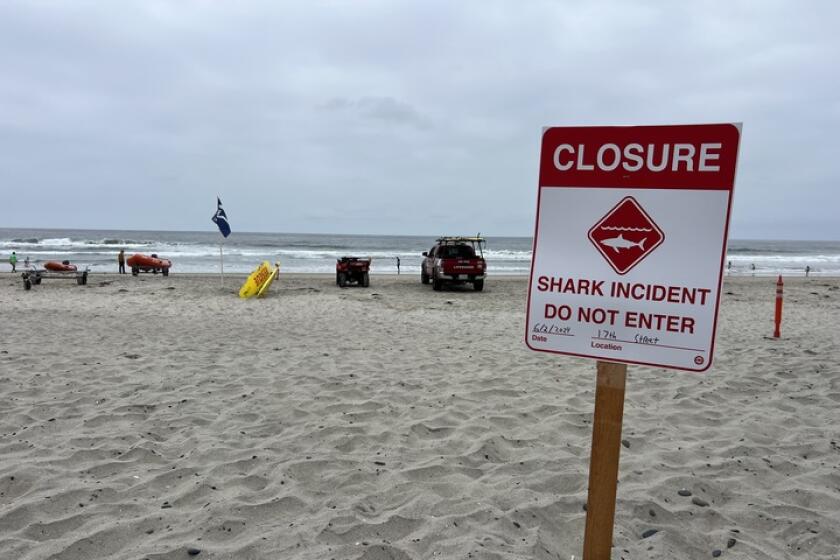Toxic Cleanup of 13 Bases Estimated to Top $3 Billion : Environment: State says costs for El Toro, Seal Beach facilities would be $325 million. Officials want to ensure availability of U.S. funds before a final decision is made on military closures.
The cost of cleaning up toxic pollution at 13 California military bases targeted for closure would top $3 billion, including at least $325 million for El Toro Marine Corps Air Station and Seal Beach Naval Weapons Station, the state’s environmental agency said Monday.
James M. Strock, California’s secretary for environmental protection, said he compiled the estimates to urge the Clinton Administration to ensure that cleanup funds are available before a final decision is made about which bases to close.
“If California is to absorb a disproportionate economic burden from these planned closures, then the Clinton Administration must guarantee that the federal government will do its part to pay the billions necessary to clean up their contamination,” Strock said in a statement. “Without these environmental cleanups, it’s a pipe dream to think these bases can be quickly converted to civilian use.”
Thirteen of the 15 California military bases included in the Defense Department’s latest round of proposed closures have major problems with chemical pollution. Only two on the list, a military language institute in Monterey and a naval hospital in Oakland, are not known to be contaminated.
At the El Toro base, eliminating waste that has polluted soil and ground water would cost at least $250 million, while cleanup of the Seal Beach station would require at least $75 million, according to the California Environmental Protection Agency.
State EPA officials stress that the estimates will probably grow, since tests to determine the scope of the environmental problems are not yet complete. The figures were based on 1992 data and could increase by 50% at each site when they are revised later this year, state EPA officials said.
“It normally grows every year,” said California EPA spokesman James Lee. “If you look at the track record, we’re averaging 50% increases in the cost estimates every year. It’s because you find new problems. Some of these facilities are hundreds of acres apiece.”
Most of the $3 billion would be needed for just the preliminary work, such as soil and water testing, not the actual cleanup, which usually involves excavation, treatment plants and water pumping, Lee said.
“If you look at El Toro’s $250-million figure, that figure is probably going to climb a lot higher,” he said. “That doesn’t include a lot of the cleanup costs.”
El Toro’s estimated cost is the third highest on the list, exceeded only by McClellan Air Force Base and the Long Beach Naval Shipyard, which would need about $1.6 billion and $300 million respectively.
The estimates could work to the advantage of Orange County officials who have argued that it would be more cost-effective to keep El Toro and instead close Miramar Naval Air Station in San Diego. Buttressing that argument, California EPA estimated that Miramar’s pollution cleanup will cost $180 million, about $70 million less than El Toro’s.
The Pentagon has its own fund for environmental cleanups, but so many bases require major work that it chronically runs out of money. Monies from Superfund--the large pool of money from fees on industry set aside for cleaning up the nation’s most severe hazardous waste sites--cannot be used for military sites.
“We want to make sure Congress and the Department of Defense know how much money we’re going to need,” Lee said.
Lee said many of the cleanups will take decades, so the Defense Department should not expect the land to be ready for civilian use soon.
The El Toro Marine base, which is on the nation’s Superfund list of the most dangerous hazardous waste dumps, has been plagued by serious toxic troubles for many years.
The 5,000-acre base has at least 22 sites where hazardous materials were dumped or spilled, including some landfills as large as 20 acres apiece. In addition to contaminated soil, the base also has tainted ground water.
The El Toro waste includes cancer-causing industrial solvents such as trichloroethylene, polychlorinated biphenyls (PCBs), low-level radioactive waste, jet fuel, used motor oil and metals, according to military records. The chemicals were dumped on the ground at the El Toro base mostly before the late 1970s, when such disposal was legal.
In the mid-1980s, water officials learned that chemicals had spread to three agricultural wells nearby. The Marines and the Orange County Water District recently mounted preliminary cleanup work to ensure it doesn’t seep into drinking-water supplies.
The Seal Beach Naval Weapons Station is also investigating soil contamination, but its problem is not as widespread or severe as El Toro’s, state health officials say.
At least four sites at the Seal Beach base contain chemical wastes from sandblasting, welding, oil drilling, missile work, metal cleaning and vehicle repair. An additional 26 sites are possibly contaminated.
*PLEA FOR BASES: California congressional group makes plea to spare military bases, jobs. B4
More to Read
More to Read
More to Read
Start your day right
Sign up for Essential California for news, features and recommendations from the L.A. Times and beyond in your inbox six days a week.
You may occasionally receive promotional content from the Los Angeles Times.






